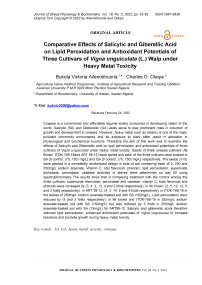Comparative effects of salicylic and giberellic acid on lipid peroxidation and antioxidant potentials of three cultivars of Vigna unguiculata (L.) Walp under heavy metal toxicity
Автор: Ailenokhuoria Bukola Victoria, Olaiya Charles O.
Журнал: Журнал стресс-физиологии и биохимии @jspb
Статья в выпуске: 3 т.18, 2022 года.
Бесплатный доступ
Cowpea is a commonest and affordable legume widely consumed in developing nation of the world. Salicylic (SA) and Gibberellic (GA) acids serve to play prominent roles in induction of growth and development in cowpea. However, heavy metal such as arsenic is one of the major pollutant commonly encountered and its exposure to plant often result in alteration in physiological and biochemical functions. Therefore the aim of this work was to examine the effects of Salicylic and Gibberellic acid on lipid peroxidation and antioxidant potentials of three cultivars of Vigna unguiculata under heavy metal toxicity. Seeds of three cowpea cultivars (Ife Brown, ITOK-768-18and ART 98-12) were sorted and each of the three cultivars were soaked in SA [0 control, (75, 150) mg/L} and GA [0 control, (75, 150) mg/L} respectively. The seeds (n=5) were planted in a completely randomised design in pots of soil containing each of 0, 250 and 500mg/L sodium arsenate. Vitamin C, otal flavonoid, phenolic, lipid peroxidation, superoxide dismutase, peroxidase, catalase activities in leaves were determined on day 90 using spectrophotometry The results show that in comparing treatment with the control among the three cultivars, superoxide dismutase, peroxidase and catalase, vitamin C, total flavonoid and phenolic were increased by (3, 4, 2, 12, 4 and 3 folds respectively), in Ife brown; (2, 5, 12, 12, 5 and 3 folds respectively), in ART 98-12; (4, 3, 14, 5 and 4 folds respectively), in ITOK-768-18 in the leaves of 250mg/L sodium arsenate-treated soil with SA (150mg/L). Lipid peroxidation were reduced by (5 and 3 folds respectively), in Ife brown and ITOK-768-18 in 250mg/L sodium arsenate-treated soil with SA (150mg/L) but was reduced by 3 folds in 250mg/L sodium arsenate-treated soil with SA (75mg/L) for ART98-12. Salicylic and gibberellic acids therefore reduced lipid peroxidation, enhanced antioxidant potentials of Vigna unguiculata to increase tolerance and promote growth during heavy metal toxicity.
Sa, ga, heavy metal, arsenic, cowpea
Короткий адрес: https://sciup.org/143179055
IDR: 143179055
Текст научной статьи Comparative effects of salicylic and giberellic acid on lipid peroxidation and antioxidant potentials of three cultivars of Vigna unguiculata (L.) Walp under heavy metal toxicity
The cowpea is an annua l herbaceous legume which utilise sandy soil and low rainfall for its growth, therefore in the dry regions all over Africa and other countries it serves as vital crop. (Maredia et al ., ,2000). Higher amount of proteins, energy, minerals and vitamins are obtained from the seed. Countries that cultivate cowpea as a main food crop uses cowpea as supplements to their cereal diet. It is referred to as meat for the poor beacause of greater levels of protein in the seed and leaves (Odenda et al., 2011).
Arsenic is an ordinary element which acts like a metal. It exist in our environment, occurring in various different forms such as inorganic or organic, with highest toxicity found in inorganic form. Arsenic exist in all the natural environment and great amount in the atmosphere. Natural sources, such as volcanoes form three quarter of arsenic in the atmosphere while the remaining are from synthetic sources. Manufacturing practices such as mining, smelting and coal-fired power plants are responsible for the arsenic presence in air, water and soils all of which account for the environmental contamination. Arsenic can occur in four oxidation states namely: +3 (arsine), 0 (arsenic metal), -3 (arsenite), and +5 (arsenate). Arsenite {As(III)} prevailed under reducing condition, while arsenate {As(V)} is more stable in oxidizing condition. Solubility in water does not take place in elemental arsenic (Jana and Choudhari, 1982). Based on the incidence of occurrence, toxicity, and the likelihood of contact with humans, arsenic has been regarded as the most harmful substance (ATSDR, 2003). Arsenic-induced reactive oxygen species (ROS) causes oxidative stress and inactivation of antioxidant enzymes necessary to protect crops against injury mediated by reactive oxygen species. The effects includes: rise in lipid peroxidation, wilting, curling, necrosis of leaf blade, reduced growth and productivity and so on (Chandrakar et al ., 2016).
Due to the fact that cowpea harbor pest both at pre and harvest stage of its production application of insecticide and pesticide is paramount. Also cowpea is being cultivated in Northern part of Nigeria where irrigation serve as substitute to rainfall, part of irrigated water may be contaminated with heavy metals predominantly arsenic based on the frequency of its occurrence.Amelioration of heavy metal toxicity to increase crop productivity has therefore been of major concern. The modulation of biological and cellular molecules by plant bioregulators (Salicylic and Gibberellic acids) for defense against ROS-induced damage may therefore serve as approach to mitigate arsenic toxicity. Salicylic and Gibberellic acids are plant bioregulators that normally partake in the control of biochemical processes, demonstrating defense against arsenic-mediated injuries in plants because ROS produced by arsenic toxicity cause hormonal imbalance in plants. Arpita (2014) found out that there is reduction in growth inhibition through pre-treatment of the seedling of mungbean with phytohormones (GA3, IAA, Kinetin and macronutrients (KH2PO4, NaH2PO4.2H2O, K2SO4.CaCl2.2H2O, MgSO4.7H2O) under sodium arsenate toxicity. Ailenokhuoria and Omolekan (2019) has also reported on evaluation of heavy metals component of our locally consumed cowpea in major markets in Ibadan and arsenic content were found to be above tolerable standard stipulated by FAO. Hence the present study on. Comparative effects of salicylic and gibberellic acid on Lipid peroxidation and antioxidant potentials of three cultivars of Vigna unguiculata (L.) Walp under heavy metal toxicity.
MATERIALS AND METHODS
Preparation of 250 mg/L sodium arsenate
Sodium arsenate (1.45g) salt was dissolve in a small volume of distilled water and then transferred to a 1 liter volumetric flask and completed to the mark with distilled water to make 250mg/L
Preparation of 500 mg/L sodium arsenate
Sodium arsenate (2.90g) salt was dissolve in a small volume of distilled water and then transferred to a 1 liter volumetric flask and completed to the mark with distilled water to make 500mg/L
Application of sodium arsenate to the soil
Five hundred millilitres of aqueous sodium arsenate prepared above was applied to each 5 kg of soil in the pot. It was left for 14 days for proper equilibration of soil and sodium arsenate.
Plant materials
Preparation of bioregulators
Bioregulators (Salicylic and Gibberellic acids) were prepared by using procedure of (Coolbear and Heydecker 1997).
Planting
Three different cultivars of cowpea (Ife brown, ART98-12 and ITO7K-568-18) were soaked in a plastic film with two concentration bioregulators (SA and GA) 75 and 150 mg/L respectively. Distilled water was used in place of bioregulators for other part of the seeds which represent the control. All were kept for 6hrs without light at room temperature. Thereafter, the solutions were decanted off, and seeds were rinsed twice with distilled water and air-dried for 1 hour. The seeds were sow under heavy metal stress, and allowed to germinate until maturity. The plants were harvested at maturity and were divided into leaf and seed for various physicochemical analysis: elemental composition, photosynthetic pigment, antioxidant enzyme activities, compatible solutes, phytochemicals, proximate analysis and growth parameters.
Determination of antioxidant enzymesSample preparation for enzyme assay
One gram of leaf were crushed in 10 ml solution containing 0.10M Potassium phosphate buffer, pH 7.5 and containing 0.50mM Ethylene diamine tetra acetic acid. The mixture formed were later centrifuged for 20 minutes at 1500 rpm and the filtrate were collected for enzymes assays.
Determination of catalase.
Procedure. Catalase activities was analysed based on Raghu et al. (2014) technique. The result was expressed as unit/mgprotein.
Principle. The principle of the test above was on the disappearance in absorbance detected at 240 nm as catalase seperate hydrogen peroxide.
Calculation
Catalase activity = A 240 /min x ml of reaction x dilution 0.0435x ml of sample x mg protein/mL
= µmH 2 O 2 /min/mg protein
Determination of superoxide dismutase.
Procedure. The SOD activity was determined by according to procedure of Shalini and Dubey (2003).
The result was expressed in unit/mg protein
Principle. Superoxide dismutase capability to obstruct the autoxidation of adrenaline at pH 0.99 by superoxide ability is the basis for this reaction. (Dhindsa, 1981).
Calculation
Rise in absorbance per minute= A 3 - A 0
2.5
Where A 0 = absorbance after 0 seconds
A 3 = absorbance after 150 seconds
% Inhibition = Rise in absorbance of substrate X 100 Rise in absorbance of blank
A unit of SOD activity is the amount of SOD necessary to produce 50% inhibition of the oxidation of adrenaline.
Determination of peroxidase
Procedure. Peroxidase activity was determine according to the method of (Raghu et al., 2014).
Principle. The method is by using pyrogallol as hydrogen donor. The rate of reaction is estimated by measurement of an increase in absorbance at 420 nm due to decomposition of hydrogen peroxide. One unit results to the decomposition of 1µM of H 2 O 2 under the specified conditions (Raghu et al., 2014). The result was expressed in abs/min
Lipid peroxidation
Malondialdehyde (MDA) contents were estimated based on Dhinsa et al. (1981) technique with slight modification. The result was expressed in nmol/g/fw
Determination of phytochemicals
Phytochemicals (total flavonoid and phenolic) are regarded as secondary defencen on enzymic antioxidants and a great removal of singlet oxygen. Vitamin C plays role in eliminating Hydrogen peroxide produced from reactive oxygen species generated from arsenic toxicity. Salicylic acid act by increasing formation of specific phytochelatin to chelate with metalloids and then reduce arsenic toxicity.
ProcedureDetermination of total phenolic
Total phenolic contents were estimated by use of folin- ciocalteau method (Singleton et al., 1999). The results were expressed as mg/GAE/g/fresh weight.
Determination of total flavonoid
The total flavonoid contents were determined by colorimetric method of Zhishen et al. (1999). Flavonoid content were expressed as mg/QUE/g/fresh weight.
Determination of Vitamin C
Vitamin C was determine according to the method of Sulladmath et al . (2012). The result was expressed as mg/g/fresh weight.
Statistical analysis
The data were analysed using Statistical analytical for science (SAS). Anova was used for separation of means. Duncan multiple range test was used to determine the level of 5% significant among the groups of treatment.
RESULTS AND DISCUSSION
The result in Figures 1-9 shows that SOD, POD and CAT activities of cowpea exposed to 250 and 500 mg/L arsenate significantly reduce with respect to the control plant respectively in all three cultivars, this was as a result of the fact that the rate of generation of oxidant surpasses the rate of production of antioxidants caused by higher level of arsenic. However, SA, GA (150, 75 mg/L) significantly increase the level of SOD, POD and CAT in all the three cultivars respectively. The enzymatic components associated with defense against reactive oxygen species generated by arsenic toxicity include SOD, catalase, peroxidase and ascorbate/ glutathione. Superoxide dismutation dissuades two superoxide radicals (O2.· ̶ ) in water and O2. and it is an important constituent of the antioxidant protective system in plants. Catalase is one of the key enzymes involved in the elimination of toxic peroxides and is universally present as oxidoreductase that decomposes hydrogen peroxide in water and molecular oxygen. (Lin and Kan, 2000). Application of SA and GA was able to upregulate the activities of these enzymic antioxidants therefore able to mitigate against arsenic toxicity and protect plant from injury. Arpital (2014) had reported that pre-treatment of mungbean seedling with GA3, KH2PO4 and NaH2PO4.2H2O which helped in reduction of oxidative stress to some extent as observed by increasing seedling growth and lowered antioxidant enzyme actions and lessening proline accumulation. Chandra et al. (2011) had also reported the alleviating effects of Indole acetic acid on effect of toxic heavy metal (Pb, Cr ) on wheat plant due to stimulatory effect of antioxidant enzyme like Superoxide dismutase, Catalase and Glutathione reductase.
Moreover, the result in Figures 10-12 shows that Lipid peroxidation of cowpea exposed to 250 and 500 mg/L arsenate significantly increase with respect to the water treated control plant respectively in all three cultivars which is due to the oxidation of polyunsaturated fatty acid of the membrane which then results in Lipidperoxidised products hence loss of function of membrane. However, SA, GA (150, 75 mg/L) significantly reduce the level of lipid peroxidation in all the three cultivars.
In addition, the result in Tables 1-3 shows that vitamin C, total flavonoid and phenolic of cowpea exposed to 250 and 500 mg/L arsenate significantly reduce with respect to control plant respectively in all three cultivars whereas SA, GA (150, 75 mg/L) significantly increase their level in all the three cultivars respectively. Vitamin C, total flavonoid and phenolic are non-enzymic antioxidant that act in addition to enzymic antioxidant to scavenge reactive oxygen species generated from arsenic toxicity. Vitamin C is a significant redox buffer that also serves as a cofactor for enzymes involved in photosynthesis, hormone production, and the regeneration of other antioxidants.. It is a critical substrate for the detoxification of reactive oxygen species. It also serve as hydrogen peroxide eliminator while total flavonoid and phenolic act as phytochelatin to chelate the metal and renders them to non- toxic forms. Amit et al. (2015) also reported that pretreatment of rice with salicylic acid also enhanced the level of Ascobate, GSH/GSSG and total non-protein thiol pon arsenate exposure in all treatments than corresponding arsenate exposed plants.
Table 1: Effects of SA and GA on Vitamin C, Total flavonoid and phenolic contents of cowpea(Ife brown) exposed to sodium arsenate
|
Arsenic |
Bioregulators |
Vitamin C (mg/g/fw) 0 24.00 ± 0.57i |
Flavonoid |
Phenolic |
|
(mg/L) |
(mg/L) 0 |
(mg QE/g/fw) 74.00±0.58d |
(mg GAE/g/fw) 92.33 ±1.45d |
|
|
250 |
0 6.70 ± 0.15g |
9.17± 0.44m |
19.30 ± 0.15m |
|
|
500 |
0 2.56 ± 0.23g |
5.47±0.15n |
14.46 ± 0.15n |
|
|
0 GA 3 150 |
31.66 ± 1.01e |
94.00±0.58a |
104.00± 0.58b |
|
|
250 GA 3 150 |
72.50 ± 1.32b |
53.50±2.78f |
69.16 ± 0.44g |
|
|
500 GA 3 150 |
42.17 ± 0.44d |
38.10±0.12h |
50.06 ± 0.62h |
|
|
0 GA 3 75 |
28.17 ± 0.44ef |
78.17±0.44c |
78.16 ±0.44e |
|
|
250 GA 3 75 |
63.50 ± 0.76c |
35.43±0.54i |
55.43±0.54i |
|
|
500 GA 3 75 |
38.50± 2.56d |
25.60±0.31k |
35.60±0.31l |
|
|
0 SA 150 |
41.50± 0.58d |
86.00±0.18b |
136.00 ±0.58a |
|
|
250 SA 150 |
83.67 ± 1.86b |
46.33±0.88g |
76.33±0.88f |
|
|
500 SA150 |
41.83± 4.47e |
30.27±0.37j |
60.26 ± 0.37h |
|
|
0 SA 75 |
33.00 ± 1.04e |
65.17±0.44e |
95.16±0.44c |
|
|
250 SA 75 |
68.17 ± 0.93b |
29.23 0.39j |
59.23 ± 0.39h |
|
|
500 SA 75 |
32.50± 1.443e |
22.13±0.19l |
48.13±0.185k |
Means with different letter are significantly different from each other
Table 2: Effects of SA and GA on Vitamin C , Total flavonoid and phenolic contents of cowpea (ART 98-12) exposed to sodium arsenate
|
Arsenic (mg/L) |
Bioregulators (mg/L) |
Vitamin C (mg/g/fw) |
Flavonoid (mgQE/g/fw) |
Phenolic (mgGAE/g/fw) |
|
0 |
0 19.40 ± 0.21 de |
55.43±0.54c |
75.60 ±0.59c |
|
|
250 |
0 10.93 ± 8.53 ef |
6.37±0.32n |
15.87 ±0.12l |
|
|
500 |
0 3.67 ± 0.88f |
3.90±0.06o |
11.93 ± 0.08m |
|
|
0 |
GA 3 150 |
25.83 ± 2.92de |
70.30±0.65a |
90.30 ±0.65b |
|
250 |
GA 3 150 |
48.83 ±9.44abc |
41.00±0.58f |
51.83 ± 0.44f |
|
500 |
GA 3 150 |
26.00 ±10.26de |
27.23±0.39i |
37.23 ±0.39i |
|
0 |
GA 3 75 |
25.00 ±2.52 de |
52.00±0.58d |
62.00 ±0.57d |
|
250 |
GA 3 75 |
50.33 ±3.82 ab |
34.00±0.58h |
38.00 ±0.57i |
|
500 |
GA 3 75 |
30.33 ± 2.85d |
16.10±0.21l |
29.10 ±0.21k |
|
0 |
SA 150 |
33.33 ± 4.42 cd |
57.63±0.33b |
107.30 ±0.45a |
|
250 |
SA 150 |
53.17 ± 4.11 a |
37.50±0.76g |
107.30±0.45a |
|
500 |
SA150 |
35.00 ± 2.84 bcd |
22.00±0.58k |
48.50 ± 0.29f |
|
0 |
SA 75 |
30.83 ± 4.08 d |
43.67±0.88e |
63.17±0.60d |
|
250 |
SA 75 |
52.50 ± 3.78 a |
25.17±0.44j |
45.17±0.44h |
|
500 |
SA 75 |
31.17 ± 3.42d |
14.00±0.58m |
34.00±0.57j |
Means with different letter are significantly different from each other
Table 3: Effects of SA and GA on Vitamin C, Total flavonoid and phenolic contents of cowpea (ART 98-12) exposed to sodium arsenate
|
Arsenic (mg/L) |
0 |
Bioregulators (mg/L) |
0 |
Vitamin C (mg/g/FW) 23.27 ± 0.50bc |
Flavonoid (mgQE/g/fw) 74.00±0.58c |
Phenolic (mg GAE/g/fw) 72.33±1.45e |
|
250 |
0 |
12.13 ± 9.43cd |
9.17±0.44j |
19.30± 0.15k |
||
|
500 |
0 |
4.87 ± 0.94d |
5.47±0.15k |
14.47±0.15l |
||
|
0 |
GA 3 150 |
26.30 ± 2.65bc |
95.00±0.58a |
104.00±0.58a |
||
|
250 |
GA 3 150 |
51.67 ± 10.84a |
53.50±2.78e |
69.17 ±0.44f |
||
|
500 |
GA 3 150 |
26.00 ± 10.27bc |
26.43±0.27i |
50.07± 0.62 i |
||
|
0 |
GA 3 75 |
26.63 ± 1.73bc |
78.17±0.44b |
88.17±0.45 b |
||
|
250 |
GA 3 75 |
60.17 ± 2.46a |
35.43±0.55g |
55.43±0.55 h |
||
|
500 |
GA 3 75 |
24.83 ± 3.09bc |
25.60±0.31i |
48.00±0.58j |
||
|
0 |
SA 150 |
33.00 ± 3.52b |
96.00±0.58a |
86.00±0.58 c |
||
|
250 |
SA 150 |
67.00 ± 5.51a |
46.33±0.88f |
76.33±0.88d |
||
|
500 |
SA150 |
34.43 ± 5.74b |
30.27±0.37h |
60.27 ±0.37g |
||
|
0 |
SA 75 |
32.47 ± 3.30b |
65.17±0.44d |
85.17±0.44 c |
||
|
250 |
SA 75 |
67.50 ± 3.75a |
29.23±0.39h |
59.23±0.39g |
||
|
500 |
SA 75 |
34.00 ± 4.04b |
52.13±0.19e |
48.13±0.19 j |
Means with different letter are significantly different from each other
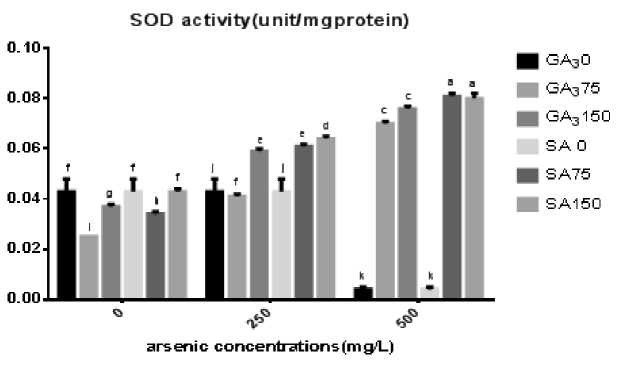
Figure 1: SOD of cowpea (Ife brown) exposed to arsenic toxicity
SOD: Superoxide Dismutase, GA 3 : Gibberellic acid, SA : Salicylic acid Means with the same letter are significantly different from each other
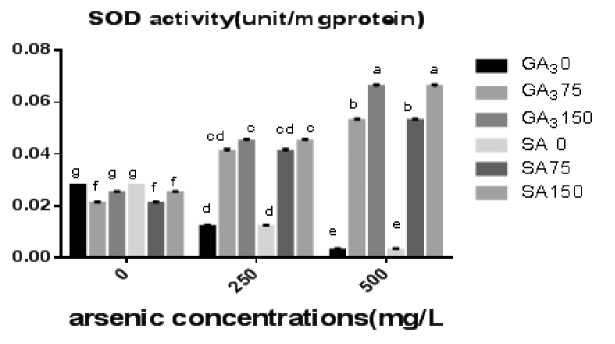
Figure 2: SOD of cowpea (ART 98-12) exposed to arsenic toxicity
SOD: Superoxide Dismutase, GA 3 : Gibberellic acid, SA : Salicylic acid Means with the same letter are significantly different from each other
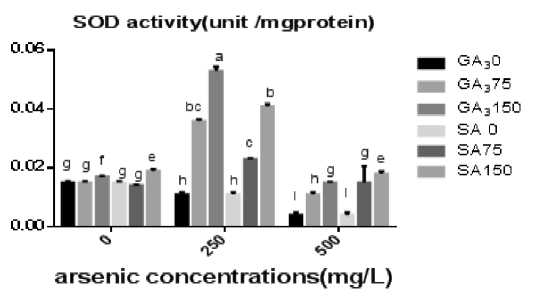
Figure 3: SOD of cowpea (ITOK-568-18) exposed to arsenic toxicity
SOD: Superoxide Dismutase, GA 3 : Gibberellic acid, SA : Salicylic acid Means with the same letter are significantly different from each other
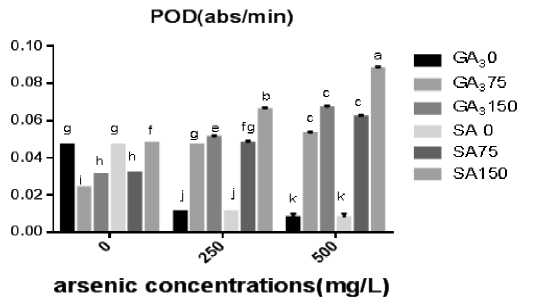
Figure 4: POD of cowpea (Ife brown) exposed to arsenic toxicity
POD: Peroxidase, GA 3 : Gibberellic acid, SA : Salicylic acid
Means with the same letter are significantly different from each other
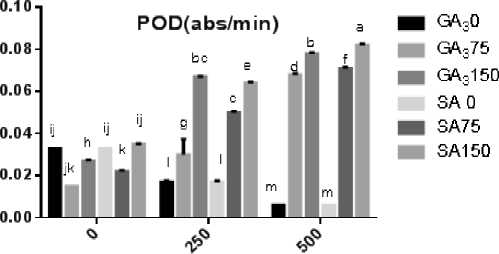
arsenic concentrations(mg/L)
Figure 5: POD of cowpea (ART 98-12) exposed to arsenic toxicity
POD: Peroxidase, GA 3 : Gibberellic acid , SA : Salicylic acid
Means with the same letter are significantly different from each other
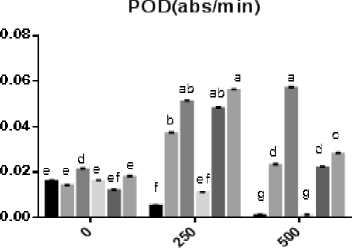
GA30 GA375 GA3150 SA 0 SA75 SA150
arsenic concentrations! mg/L)
Figure 6: POD of cowpea (ITOK-568-18) exposed to arsenic toxicity
POD: Peroxidase, GA 3 : Gibberellic acid, SA : Salicylic acid
Means with the same letter are significantly different from each other
Catalase( unit/m g prote in)
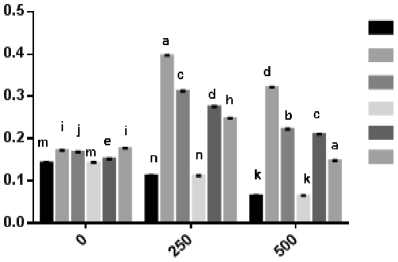
GA30 GA375 GA3150 SA 0 SA75 SA150
arsenic concentrations! mg/L)
Catalase(unit/mgprotein)
Figure 7: Catalase of cowpea (Ife brown) exposed to arsenic toxicity
GA 3 : Gibberellic acid, SA : Salicylic acid
Means with the same letter are significantly different from each other
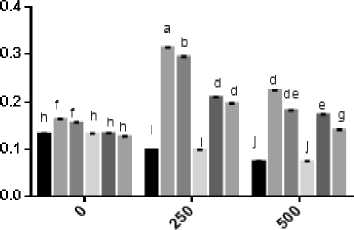
ga3o GA375 GA3150 SA □ SA75 SA 150
arsenic concentrations(mg/L)
Figure 8: Catalase of cowpea (ART98-12) exposed to arsenic toxicity
SOD: Superoxide Dismutase, GA 3 : Gibberellic acid, SA : Salicylic acid Means with the same letter are significantly different from each other

Figure 9: Catalase of cowpea (ITOK-568-18) exposed to arsenic toxicity
GA3 : Gibberellic acid , SA : Salicylic acid
Means with the same letter are significantly different from each other
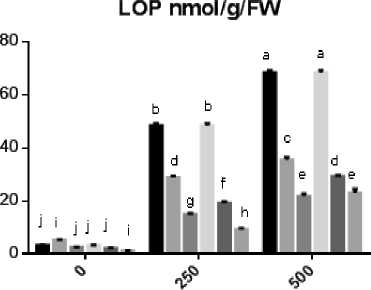
■ ga3o
GA375
■ GA3150 SA 0
■ SA75 SA 150
arsenic concentrations(mg/L)
Figure 10: Lipid peroxidation of cowpea (Ife brown) exposed to arsenic toxicity GA3 : Gibberellic acid , SA : Salicylic acid
Means with the same letter are significantly different from each other
LOP nmol/g/FW
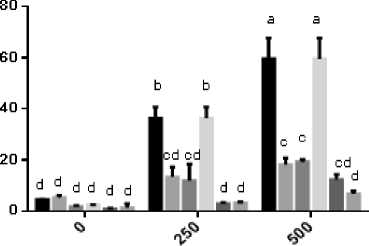
■ GA30 GA375 GA3150 SAO ■ SA75 SA150
arsenic concentrations(mg/L)
Figure 11: Lipid peroxidation of cowpea (ART 98-12) exposed to arsenic toxicity
GA3 : Gibberellic acid , SA : Salicylic acid
Means with the same letter are significantly different from each other

Figure 12: Lipid peroxidation of cowpea (ITOK-568-18) exposed to arsenic toxicity
Means with the same letter are significantly different from each other
CONCLUSIONS
Arsenic is a carcinogenic chemical that is found in our environment due to pollution from both natural and human source. However, continuous plant contamination with arsenic increases its movement along food chain which is` health hazard. Bioregulators such as salicylic and gibberellic acid have been shown to regulate some biochemical processes in plants and therefore serve as a potential modulator of antioxidant enzymes to mitigate arsenic toxicity. In the present study, three cultivars of cowpea seed pre-treated with salicylic acid and gibberrellic acid show varying modulatory effects against arsenic toxicity through increase in the level of both antioxidant enzymes (SOD, POD and catalase) and non enzymic antioxidant (vitamin C, flavonoid and phenolic) and therefore promote growth during heavy metal toxicity. Hence there is possibility of optimal growth and productivity during heavy metal stress in cowpea through application of salicylic and gibberellic acids and this would be of great value to agricultural producers.
ACKNOWLEDGEMENTS
CONFLICTS OF INTEREST
The authors declare that they do not have any conflict of interest for publishing this research.
Список литературы Comparative effects of salicylic and giberellic acid on lipid peroxidation and antioxidant potentials of three cultivars of Vigna unguiculata (L.) Walp under heavy metal toxicity
- Ailenokhuoria B.V. and Omolekan T.O. (2019) Heavy metal, Proximate and Antioxidant Composition of five cultivars of (Vigna unguiculata L.) in Ibadan, Oyo State, Nigeria. J. Food Science, Nutrition Res. 2019, 2(4): 327-332. DOI 10.26502/ifsn.2642-1100031) U.S.A..
- Amit PS, Garima D, Seema M, Sanjay D, Manish T, Shekhar M, Vivek P, Prabodh KT, Debasis C & Rudra D.T (2015) Modulation of arsenic toxicity by Salicylic acid via reduction of the root for the translocation of the outbreak in rice Plant physiology, Frontier in Plant Science 6: 340
- Agency for the registration of toxic substances and diseases (ATSDR) (2003) Toxicological profile of arsenic. Atlanta, GA, U.S. Department of Health and Human Services. UU. Issue 12:202.
- Arpita (2014) Induction of Oxidative Stress and Osmolyte retention in Response to toxic effects of Sodium Arsenate in Mungbean Seedlings and Its mitigation Resource Journal. Chemistry. Environmental. Science. 2(2); 61-67.
- Chandra S. K, Alka Singh, Sagar R.K, . Maurya J.N (2011) Effect of Indole Acetic Acid on Wheat (Triticum aestivum L.) Irrigated with Sewage Water Journal of Phytology 3(8): 08-11
- Chandrakar, V., Naithani, S.C. & Keshavkant, S. (2016). Arsenic-induced metabolic disturbances and their mitigation mechanisms in crop plants: A review. Biologia 71, 367-377 https://doi.org/10.1515/biolog-2016-0052
- Coolbear, P. (1977). Seed treatments for improved performance- survey and attempted prognosis. Seed Sci.Technol. 5, 353-425
- Dhindsa S.R, Plumb D.P, Thorpe A.T. (1981) Senescence of the leaf: correlation with higher level of membrane permeability and lipid peroxidation, and lower levels of superoxide dismutase and catalase. Journal of Experimental Botany 32: 98-99.
- Lin C.C, Kao C.H. (2000) Effect of NaCl stress on H2O2 metabolism in rice leaves, Plant Growth Regul. 30: 151-155
- Jana S, Choudhari M.A. (1982) Senescence in submerged aquatic angiosperms: effects of heavy metals. New Phytol. 90: 477- 484.
- Maredia, M. K., Byerlee, D., & Pee, P. (2000). Impacts of food crop improvement research: evidence from sub-Saharan Africa. Food policy, 25(5), 531-559.
- Monisha J, Tenzin T, Naresh A, Blessy B.M. Krishnamurthy N.B. (2014): Toxicity, mechanism and health effects of some heavy metals, Journal of interdiscip Toxicol. 7(2): 60-72., doi: 10.2478/intox-2014-0009
- Odendo, M., Bationo, A., & Kimani, S. (2011). Socioeconomic contribution of legumes to livelihoods in Sub-Saharan Africa. In Fighting poverty in Sub-Saharan Africa: the multiple roles of legumes in Integrated Soil Fertility Management (pp. 27-46). Springer, Dordrecht.
- Raghu, K., Mahesh, K., Seeta R. S and Divya.N.S. (2014): Brassinosteroid role of the radish seedlings (Raphanus sativus L.) on thegermination of seeds and its growth under arsenic toxicity stress International Journal. of Developmental Research 4, (9): 1929-1933.
- Singleton V.L, Rudolf O, Rosa M.L. (1999) Analysis of total phenols and other oxidation substrates and antioxidants by means of folin-ciocalteu reagent, Methods in enzymology, 29: 152-178, https://doi.org/10.1016/S0076-6879(99)99017-1.
- Sulladmath VV, Srinivas.K, Laxman R.H. (2012) Yield and Quality of Passion Fruit in Relation to Training Systems. Journal of Horticultural 7(1). 40-65
- Zhishen. J, Tang. M and Wu. J. (1999) The determination of flavonoid contents in mulberry and their scavenging effects on superoxide radicals, Food chemistry, 64(4): 555-559, https://doi.org/10.1016/S0308-8146(98)0010.

